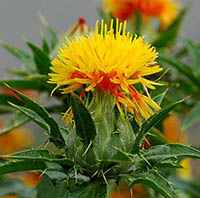There’s another great Western substitute for a Chinese herb: Calendula officinalis can stand in for safflower (hong hua, Carthamus tinctorius). The two are flowers, one being deep gold to orange in color and the other red respectively, but both are light in weight so they quickly spread throughout the body. Unfortunately, calendula is not fully used internally anymore, which means it misses many treatments that its counterpart safflower treats, and vice versa. This means both can have new applications – here’s how: Calendula flower (Calendula officinalis; Asteraceae) has a neutral energy, is slightly acrid and bitter, and enters the Liver, Heart, and Lungs. It has emmenagogue, diaphoretic, alterative, anti-inflammatory, antiviral, analgesic, antibacterial, antimicrobial, antiseptic, and astringent properties.
In today’s commercialized herbal world, calendula is mainly known for granulating flesh and healing all sorts of skin complaints such as inflammations, dermatitis, cuts, bruises, diaper rash, sore nipples, strains, lesions, minor burns, herpes sores, eczema, boils, itching, insect stings, shingles, erysipelas, lacerated perineum, and slow-healing wounds and ulcers. It is also known to promote the ripening and completion of eruptive skin diseases such as measles. For these it is used as a poultice, lotion, compress, or mouthwash, although its fresh succus (juice) may be topically applied as well and its oil can be directly inserted into the ear for earaches.
With this long list, who would look for further uses of calendula? But it is secondarily known to promote sweating for treating fevers and more recently, as a great anti-fungal for candidiasis, vaginitis, and athlete’s foot. However, calendula has lost other valuable applications and looking at safflower highlights these.

Safflower (Carthamus tinctorius; Asteraceae; hong hua) has a slightly warm energy. Like calendula it also has acrid and bitter flavors and enters the Liver, Heart, and Lungs. It has emmenagogue, analgesic, carminative, and mild diaphoretic properties.
However, the Chinese mainly use safflower for its Blood-invigorating properties. It’s especially taken to treat all types of pain, particularly lower abdominal pain (especially in women) and chest pain. As well, it’s widely used to unblock the menses for treating delayed or scanty menses, amenorrhea, dysmenorrhea, abdominal masses, and retained lochia. Lastly, it’s applied to toxic swellings and given for blood clots.
Calendula, when taken internally, does act very similarly to safflower. While it is known to treat abdominal cramps, what does that actually mean? Here it means it moves Blood and so like safflower, also regulates menses to treat delayed or scanty menses, amenorrhea, and dysmenorrhea. Because safflower is so effective for this, we should be using calendula much more for these conditions.
Could calendula then also be used for abdominal masses, toxic swellings and blood clots? Its close properties to safflower indicate this very likely. Likewise, why not try calendula for abdominal and chest pain since its safflower counterpart is mainly used for these?
On the other hand, safflower can be more widely used for skin complaints. Most Chinese herbalists know that it does treat the incomplete expression of measles and rashes as well as sores, bruises, contusions, injuries, trauma, carbuncles, and dark purplish erythema, but why not extend this to cover all the many other skin complaints that calendula treats plus try it as ear oil for earaches, too?
Both herbs could be extended to treat more cardiovascular conditions such as palpitations, abnormal cardiac activity, and varicosities. Now safflower is known to moisten dryness so perhaps calendula could be used for this, too. And does calendula’s anti-fungal properties extend to safflower?
The dosage of safflower could influence how we use calendula as well. In large doses (9-12 g), safflower very rapidly invigorates the Blood (because it is light in weight) and dispels stasis, while in small doses (2-2.5 g) it harmonizes the Blood (nourishes it). The same may be true for calendula.
Both herbs should be avoided during pregnancy. However, safflower is contraindicated during any bleeding conditions or peptic ulcers, so perhaps calendula should be avoided with these, too.


Thank you Leslie and Michael for keeping me enlightened, and always broadening my education. Really liked the info on Heat vs inflamation.
Sincerly,
Phil Goshorn